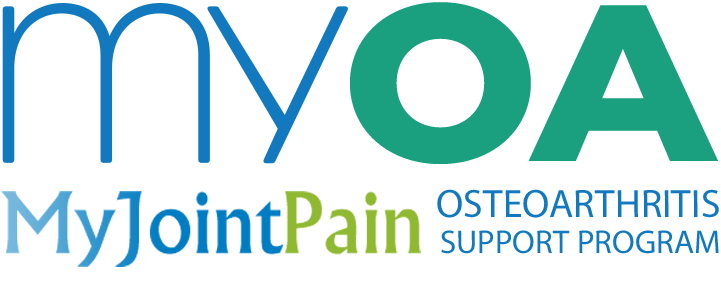
This resource provides general information about the main types of medicines used for arthritis. It also gives tips on the safe use of medicines and where to go for further information. This resource does not cover the full range of possible side effects for each medicine and you should discuss this further with your doctor or pharmacist.
Pain relievers (analgesics) are often the first medicine your doctor will recommend to help with pain. Some pain relievers are available without a prescription, while others must be prescribed by a doctor.
Types: Simple pain relievers such as non-steroidal anti-inflammatory drugs (NSAIDs) and paracetamol are commonly used by people with osteoarthritis (OA) There are also stronger pain relievers, such as a combination of paracetamol and codeine, tramadol and a range of morphine-like medicines (opiates). Stronger pain relievers such as opiates are not recommended and should be considered a last resort option.
Effects: Pain relievers act on the nervous system to reduce pain. They typically do not affect other symptoms such as joint swelling or stiffness.
How are they used: In some cases, pain can be controlled by using an analgesic just when it is needed. Sometimes, pain is better controlled by taking an analgesic regularly, for example, four times a day. Ask your doctor or pharmacist for advice on the best way to take analgesics for your condition.
Risks: Some pain medicines have side effects which need to be considered in balance with the relief they may provide. Taking more than the recommended daily dose can potentially cause severe problems. Be careful when taking pain relievers with over the-counter medicines, such as ‘cold and flu’ medicines. These medicines may also contain paracetamol and you may accidentally take more than the recommended daily dose. Always ask your pharmacist for advice before taking any over-the-counter medicines. Stronger pain relievers may cause constipation, nausea, vomiting, drowsiness. Opiates have serious risks, such as drug dependence and overdose, and also increase the risk of falls, respiratory failure and death.
Paracetamol
Paracetamol, also known as acetaminophen, is a simple pain reliever that is commonly used by people with OA. While paracetamol is a commonly chosen pain reliever for osteoarthritis, its effectiveness varies among individuals. Current research evidence does not support the use of paracetamol for pain management in OA.
Types and brand names: Paracetamol is available in various formulations and brand names. Some common brand names include Panadol, Panadol Osteo Herron, Panamax, Chemist Own, Hedanol (in Aldi) and Dymadon. Most pharmacy chains also have their own "house brands". These brands may offer different formulations such as standard tablets, extended-release tablets, liquid suspensions, and chewable tablets. It is essential to consult with your doctor or pharmacist to determine the most suitable form for your needs.
Effects: Current research indicates that paracetamol may not significantly reduce pain or improve physical function in individuals with knee or hip osteoarthritis.1,2 It is important to note that individual responses may vary. Some people with OA may experience decreased pain after taking paracetamol, although the specific reasons for this effect remain unknown. It is advisable to carefully monitor your personal response to paracetamol and communicate any concerns or improvements to your doctor and healthcare team.
How are they used: Follow the recommended dosage instructions provided by your doctor or pharmacist or as indicated on the product packaging. Exceeding the recommended dose can lead to adverse effects. Do not take paracetamol more frequently than directed, and avoid combining it with other medications containing paracetamol to prevent accidental overdose.
Non-steroidal anti-inflammatory drugs (NSAIDs)
NSAIDs reduce inflammation, joint swelling and stiffness. They are often used as a treatment for inflammatory forms of arthritis, such as rheumatoid arthritis. NSAIDs are more effective than paracetamol for managing OA pain. Some NSAIDs are available without a prescription, while others must be prescribed by a doctor. Some are available as a topical gel while most are available orally (e.g. as a tablet)
Types and brand names: There are many different types of NSAIDs available, some over the counter brands include Diclofenac (Voltaren, Fenac), Ibuprofen (Neurofen, Brufen, Advil, Hedafen).
There is a certain group of NSAIDs called COX-2 inhibitors that are slightly less likely to cause stomach problems. This group of NSAIDs require a prescription from your doctor. Common types and brands are Naproxen (naprosyn), Indomethacin (Indocid, Arthrexin), Piroxicam (Feldene), Ketoprofen (Orudis), Meloxicam (Mobic, movalis) Celecoxib (Celebrex, Celaxib, Celexi).
Effects: NSAIDs stop the body from producing substances (prostaglandins) that cause inflammation. This reduces symptoms such as pain and swelling. NSAIDs do not cure or have a long-term effect on your arthritis.3
How are they used: Some symptoms can be effectively controlled by using NSAIDs occasionally, i.e. as needed. Other conditions may require more regular use of NSAIDs. Ask your doctor or pharmacist for advice on the best way to take NSAIDs for your condition and how to reduce the dose of NSAIDs if your pain is less.
Risks: Always talk to your doctor or pharmacist before taking NSAIDs as they may cause serious side effects compared to paracetamol3. If you have problems with your blood pressure, kidneys or heart then the risk of heart attack, stroke and kidney failure may be increased in a small number of people.
One of the most serious side effects of NSAIDs is bleeding of the stomach and upper intestine. Signs of bleeding include stomach pain, blood in your stools (or dark stools) and coffee-coloured vomit. You should see your doctor as soon as possible if you have any of these signs while taking NSAIDs. Even though some NSAIDs are available without prescription, your doctor can advise which of the NSAIDs and dosage are best for you.
Corticosteroids
Corticosteroids are used to treat inflammatory forms of arthritis, such as rheumatoid arthritis. They can sometimes be used to treat a single inflamed joint.
Types: Corticosteroids can be given by injection into a joint, muscle or soft tissue. Oral corticosteroids are not recommended and should be considered a last resort option.4
Effects: These medicines have a strong anti- inflammatory effect and reduce pain and swelling. However, they do not cure the disease. How are they used: Intra-articular corticosteroids are not first-line treatments for OA5. They should always be performed by a trained health professional under sterile conditions. If your doctor prescribes oral corticosteroids, it should be the lowest possible dose for the shortest time, due to the risk of side effects. Corticosteroids may be effective to reduce pain during a ‘flare’ (when symptoms worsen for a period of time).
Risks: Corticosteroids can have serious side effects if taken in high doses or for a long time (more than a few weeks). Your doctor will monitor you for side effects while you are taking corticosteroids. Common side effects include weight gain, thinning of the bones (osteoporosis), high blood pressure and increased susceptibility to infection. Regular corticosteroid injection use is not recommended due to short duration of pain relief. Current evidence suggests that repeated corticosteroid injections may worsen OA long term6.
Opioids
Opioids are not recommended as a treatment for osteoarthritis7,8. Opioids are a class of strong pain-relieving medications that are only considered for managing severe pain8. Opioids are typically reserved as a last resort where other treatments have proven insufficient in providing adequate pain relief. Current clinical guidelines emphasise the importance of exploring other options first4,9, see the ‘Managing OA Pain’ fact sheet.
Types: Opioids come in various formulations and brand names. Some common opioids include Oxycodone (endone, oxynorm), Morphine (MS contin), Codeine with paracetamol (panadeine forte, codalgin forte, prodeine forte),Tramadol (Tramal, tramedo, zydol) These medications may be prescribed in different forms such as tablets, capsules, patches, or liquid solutions. It is essential to consult with your doctor to understand the specific type and formulation prescribed for your condition.
Effects: Opioids work by binding to specific receptors in the brain and spinal cord, reducing the perception of pain. While they can be highly effective in managing severe pain, they also carry risks of dependence, tolerance, and side effects such as constipation, drowsiness, and nausea. Opioids should only be used under the close supervision of your doctor.
How are they used: Always follow the prescribed dosage instructions provided by your doctor. Do not exceed the recommended dose to avoid potential risks and side effects. Use opioids for the shortest duration necessary to manage your pain effectively. Prolonged use increases the risk of dependence and other complications.
Duloxetine
Duloxetine is a medication classified as a serotonin-norepinephrine reuptake inhibitor (SNRI) and is sometimes considered for managing pain associated with conditions like osteoarthritis. While duloxetine has been shown to be effective in managing certain types of chronic pain, current clinical guidelines do not support duloxetine as a first-line treatment for osteoarthritis.4 See the ‘Managing OA Pain’ fact sheet.
Types: Duloxetine is available under various brand names, and it is commonly prescribed for both mood disorders and certain chronic pain conditions. Some brand names include Cymbalta and Duloxecor. It is essential to consult with your doctor or pharmacist understand the specific type and formulation prescribed to you.
Effects: Duloxetine works by increasing the levels of serotonin and norepinephrine in the brain, these are neurotransmitters which can help modulate pain signals. In addition to its pain-relieving effects, duloxetine is also used to manage mood disorders such as depression and anxiety. It may take some time for the full therapeutic effects to be felt, so consistency in taking the medication as prescribed is important.
How are they used: Follow the prescribed dosage instructions provided by your doctor. Do not adjust the dosage without consulting your doctor. It may take several weeks for the full benefits to be realised. Do not discontinue the medication abruptly, and discuss any concerns about side effects or efficacy with your doctor.
Risks: Duloxetine may cause drowsiness or dizziness. Use caution when driving or operating machinery until you are familiar with how the medication affects you.
Dietary Supplements
Certain dietary supplements, including glucosamine, chondroitin, fish oils, and turmeric, are often used by individuals seeking additional relief for osteoarthritis symptoms. Current evidence and clinical guidelines have identified that further research is required to support the benefits for supplement use in osteoarthritis4,9. Dietary supplements can be expensive, it is important to discuss the potential benefits and risks of supplement use with your doctor, pharmacist or dietitian before you incorporate into your management plan.
Glucosamine
Type: Glucosamine is a natural compound found in the body and is commonly derived from shellfish or processed grains for supplement purposes. Use: It is often taken to support joint health and reduce arthritis-related symptoms. Research Evidence: The effectiveness of glucosamine in managing osteoarthritis symptoms is debated, and current research lacks consistent evidence supporting its widespread use.4,9,10
Chondroitin:
Type: Chondroitin is a component of cartilage that is commonly sourced from animal cartilage or produced synthetically.
Use: Like glucosamine, chondroitin is used to support joint health and potentially alleviate arthritis symptoms. Research Evidence: The scientific evidence supporting the efficacy of chondroitin for osteoarthritis is limited, and further research is needed to establish its benefits conclusively.4,9,11
Fish Oils:
Type: Fish oils contain omega-3 fatty acids, which are believed to have anti-inflammatory properties.
Use: Fish oil supplements are often taken to reduce inflammation and potentially ease osteoarthritis symptoms.
Research Evidence: While there is some suggestive evidence regarding the anti-inflammatory effects of omega-3 fatty acids, more research is required to determine their specific impact on osteoarthritis.4,9,12
Turmeric:
Type: Turmeric contains curcumin, a compound with potential anti-inflammatory properties.
Use: Turmeric supplements are popular for their perceived ability to reduce inflammation and alleviate arthritis discomfort.
Research Evidence: While preliminary studies are promising, the overall evidence supporting the efficacy of turmeric in arthritis management is still inconclusive, and more research is needed.4,9,13
Important medicine tips:
- Understand why you are taking the medicine and what the possible side effects are. Ask your pharmacist for the Consumer Medicines Information (CMI) leaflet for your medicine. See the Australian Rheumatology Association’s Patient Medicine Information or ask your rheumatologist for a copy.
- Always read all medicine labels and take your medicines as directed. If you have any questions check with your doctor or pharmacist.
- Keep a personal record of all your medicines with you, including doses and allergies. This can be useful when you are talking to your doctor or pharmacist.
- Always talk to your doctor or pharmacist before taking any over-the-counter medicines, including natural medicines, as some medicines cause problems if taken together.
- Do not share your medicines with friends or relatives – the medicines you are taking may be harmful to them.
Your healthcare team can give you more advice and information about whether any of these or other treatments might be useful for you.
Other Resources
State/Territory Arthritis Offices
Your local Arthritis Office can provide further information to assist you and will have a range of education and support activities. Click here to find your local office.
The Australian Rheumatology Association
The Australian Rheumatology Association has information sheets on NSAIDs, corticosteroids and each of the DMARDs and biological DMARDs. The sheets cover detailed information about how to take the medicine, side effects and precautions. These are available online at: http://www.rheumatology.org.au/
Medicines Line
Call the Medicines Line, a telephone service provided by the National Prescribing Service and healthdirect Australia, for independent information about prescription, over-the-counter and natural medicines from a registered nurse. Your question may be answered on the spot, or you may be referred to your GP or pharmacist, or put through to a NPS pharmacist. Phone: 1300 633 424 Monday to Friday, 9am to 5pm EST. Web: www.nps.org.au
Podcasts:
https://shows.acast.com/joint-action/episodes/medications-and-osteoarthritis
Joint action Podcast- What anti-inflammatory should I take for my osteoarthritis? with Ric Day: https://shows.acast.com/joint-action/episodes/what-anti-inflammatory-should-i-take-for-osteoarthritis
Joint action Podcast- Leeches, honey bees and snake oil - what supplement can I take for my joint pain?: https://shows.acast.com/joint-action/episodes/leeches-honey-bees-and-snake-oil
The below references have been used to develop this fact sheet with the most up-to-date evidence available.
References
- Abdel Shaheed C, Ferreira GE, Dmitritchenko A, et al. The efficacy and safety of paracetamol for pain relief: an overview of systematic reviews. Medical journal of Australia. 2021;214(7):324-331.
- Conaghan PG, Arden N, Avouac B, Migliore A, Rizzoli R. Safety of Paracetamol in Osteoarthritis: What Does the Literature Say? Drugs & Aging. 2019;36(1):7-14.
- da Costa BR, Reichenbach S, Keller N, et al. Effectiveness of non-steroidal anti-inflammatory drugs for the treatment of pain in knee and hip osteoarthritis: a network meta-analysis. The Lancet (British edition). 2017;390(10090):e21.
- Gibbs AJ, Gray B, Wallis JA, et al. Recommendations for the management of hip and knee osteoarthritis: A systematic review of clinical practice guidelines. Osteoarthritis and cartilage. 2023;31(10):1280-1292.
- Yu SP, Hunter DJ. Intra-articular therapies for osteoarthritis. Expert Opinion on Pharmacotherapy. 2016;17(15):2057-2071.
- McAlindon TE, LaValley MP, Harvey WF, et al. Effect of Intra-articular Triamcinolone vs Saline on Knee Cartilage Volume and Pain in Patients With Knee Osteoarthritis: A Randomized Clinical Trial. JAMA. 2017;317(19):1967-1975.
- da Costa BR, Pereira TV, Saadat P, et al. Effectiveness and safety of non-steroidal anti-inflammatory drugs and opioid treatment for knee and hip osteoarthritis: network meta-analysis. BMJ (Online). 2021;375:n2321-n2321.
- Osani MC, Lohmander LS, Bannuru RR. Is There Any Role for Opioids in the Management of Knee and Hip Osteoarthritis? A Systematic Review and Meta-Analysis. Arthritis Care & Research. 2021;73(10):1413-1424.
- Gray B, Gibbs A, Bowden JL, et al. Appraisal of quality and analysis of the similarities and differences between osteoarthritis Clinical Practice Guideline recommendations: A systematic review. Osteoarthritis and Cartilage. 2024.
- Towheed T, Maxwell L, Anastassiades TP, et al. Glucosamine therapy for treating osteoarthritis. Cochrane Database of Systematic Reviews. 2005(2).
- Singh JA, Noorbaloochi S, MacDonald R, Maxwell LJ. Chondroitin for osteoarthritis. Cochrane Database of Systematic Reviews. 2015(1).
- Hill CL, March LM, Aitken D, et al. Fish oil in knee osteoarthritis: a randomised clinical trial of low dose versus high dose. Annals of the Rheumatic Diseases. 2016;75(1):23-29.
- Prasad S, Gupta SC, Tyagi AK, Aggarwal BB. Curcumin, a component of golden spice: From bedside to bench and back. Biotechnology Advances. 2014;32(6):1053-1064.






